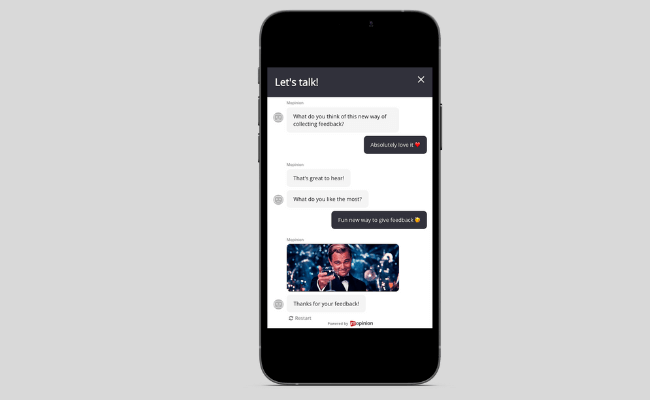Over the last few years, user feedback has swept the market, climbing to the top of nearly every digital marketer’s agenda. However, as the adoption of feedback tools continues to rise, there seems to be a misconception circling among these organisations. “If I collect user feedback, the rest will fall into place”. Alas, this isn’t a realistic view – especially for organisations that are looking to make a real impact on their customer experience. The fact of the matter is – while user feedback isn’t a complex undertaking, it is one that requires strategy, critical thinking and a customer-first approach. For an effective user feedback strategy, organisations must have a well-founded plan that works to achieve their goals and advance their digital strategy.
That being said, Mopinion has coalesced 10 best practices for an effective user feedback strategy. Read on to learn more…
10 Best Practices for an effective User Feedback Strategy
These best practices that will take your user feedback strategy from start to finish:
1. Come up with a game plan
2. Share that game plan with your team
3. Create surveys with the user in mind
4. Keep interactions human
5. Make your feedback surveys easily accessible to your visitors
6. Capture user feedback frequently
7. Analyse your feedback
8. Set priorities for incoming feedback data
9. Close the feedback loop
10. Evaluate regularly with your team
Let’s get started…
1. Come up with a game plan
As with every business plan, it’s important to lay out your goals and objectives for initiating a user feedback programme. In other words, what do you want to achieve?
You should think about:
- Why do you want to collect feedback? What kinds of insights do you want to gather from your users, and why?
- Where do you want to collect user feedback? Which digital channels do you intend to optimise (if not all)?
Why do you want to collect user feedback?
There are many ways in which user feedback can cater to your digital strategy. But what is your goal?
For example, some organisations (many retailers, in fact) are heavily focused on loyalty metrics such as NPS or CSAT and want to learn more about post-purchase opinions, whereas others want to delve into the online journey as it happens and gather user experience feedback during certain online funnels.
Where do you want to collect user feedback?
Now that online experiences are becoming more fluid and viewed as one single experience by the consumer, more organisations are focusing on optimising all of their channels. That is why it is important to consider which (if not all) channels you want to optimise. Many user feedback software – such as Mopinion – offer solutions for website(s), mobile app(s) and email so that you have all of your bases covered.
Learn more about how to gather customer experience feedback on these channels here.

If you outline these objective(s) properly, it will help you come up with the right (and most relevant) questions to ask later on in the process.
2. Share that game plan with your team
User feedback isn’t a one-person job. Implementing a good user feedback programme is a team effort, which is why it’s important to get the right people on board with user feedback. Depending on which departments or teams you plan to involve, now is the time to invite them to the project. Discuss who will do what in terms of collecting, analysing and taking action on feedback. This is critical, as otherwise all of your feedback data will likely get siloed into one or two departments.
One way to do this is to set up integrations between your user feedback solution and the project management and customer data and/or messaging systems your team members use. This way you can easily push data to your other platform and keep team members abreast of the latest developments.
3. Create surveys with the user in mind
One of the biggest mistakes many companies make is slapping a long and intricate survey on their website, in hopes of gathering all the insights they need at once. Unfortunately, however, this strategy tends to push customers away rather than reel them in. And it’s a perfect example of why we need to create user-centred surveys. So what can you do to make sure your user feedback surveys are both beneficial to you and your customers? Here are a few suggestions:
- Brief is better. The majority of your customers simply do not have the time to go through and answer long and drawn out feedback surveys. It’s a hassle for them, and it has a high likelihood of causing what we call ‘feedback fatigue’.
- Keep it simple. Don’t make your questions too intricate – be clear in what you are asking so your customers understand. Always try to incorporate one or two questions that require an open-text answer. These will give you deeper insights into how your customers feel.
- Ask questions that are relevant. There are appropriate questions and inappropriate questions to ask, depending on your goal(s). Timing is very important and surveys should be situational.
4. Keep interactions human
More and more customers are looking for relatable, personal and human interactions with brands. That being said, organisations are having to switch gears and cater to their customers on a more personal level.
In order to make your feedback efforts more human, a great solution is conversational feedback. Conversational feedback is a relatively new-to-market approach to conversational marketing. This type of feedback allows organisations to collect feedback in a way that is casual, fun and personal, allowing customers to really open up. The result? Increased response rates and even richer insights.

Learn more about conversational feedback here.
5. Make your feedback surveys easily accessible to your visitors
Want to gather meaningful and relevant user feedback data? Then you’re going to have to make it easy for your visitors to give you feedback in the first place…
In fact, accessibility plays a key role in gathering relevant feedback across your digital channels, whether that’s by deploying a feedback button on all pages making it possible for the visitor to provide feedback whenever they want, or by displaying a survey somewhere in the funnel, which appears depending on certain behavioural triggers.
These two types of feedback, also referred to as passive feedback and active feedback, can make a huge difference in how you optimise the online journey.
A passive feedback survey is a user-initiated feedback survey visible on websites and mobile apps in the form of a tab or icon. This method is great for gathering feedback anywhere across your digital channels and gives the visitor the freedom to do so whenever they want. Active feedback surveys are company-initiated feedback surveys that appear on the page as the result of a certain behaviour or trigger. These are ideal for gathering feedback in the moment, i.e., when a visitor leaves the shopping cart or intends to leave the page.
Want to learn more? Here is some additional information on the benefits of passive and active feedback.
6. Capture user feedback frequently
You’ve heard it all before… Consistency is key. And not shockingly, this rings true for user feedback as well. It is not a one-off event or annual exchange of information between the customer and the organisation. It’s something that must be leveraged on an ongoing basis.
User feedback helps organisations keep a pulse on their online customer journey. It gives them access to user opinions and insights that will ultimately help them optimise online funnels, page content, design elements and more.
This is especially important as customer expectations continue to rise and new trends emerge.
7. Analyse your feedback
Collecting feedback is only half the battle. Interpreting what this data means for the organisation and how it can help improve the online experience is critical.
Customer feedback analytics provides organisations with a digestible way of bringing feedback data together and identifying key bottlenecks and trends. Rather than wasting time analysing this data manually in external tools, a good customer feedback analytics solution will sort and display your data in one place using organised dashboards and charts.

There are many ways of analysing your user feedback depending on your goals with the data. For example, laying out certain trends and KPIs, channel performance, campaign performance and so on.
Learn more about how solutions ilke Mopinion help you analyse your feedback.
8. Set priorities for incoming feedback data
This goes hand in hand with the practice of analysing your feedback (as mentioned above). It is very important to the success of your user feedback programme to think about how you’re going to organise and prioritise your feedback data.
Tagging
A great way to keep your feedback data organised is by tagging items based on their category. By ‘tagging’ or categorising certain items with a label, it’s very easy to search and group similar feedback items together. This also makes it easier to assign tasks to the right teams. For example, if you add the tag ‘bug or error’, it is immediately clear for your IT team to see that that particular item is for them to solve. Alternatively, if you add the tag ‘expensive’ or ‘pricing’, your sales team will know to involve themselves in the matter.
In fact, some feedback software solutions such as Mopinion even leverage machine learning technology that allows for this process to be done intelligently and automatically. The user simply has to specify the conditions in which tags should be added to feedback items and based on the parameters, the items will be tagged automatically.
Feedback alerts
Feedback email alerts might be a good option for making a priority out of the more urgent incoming feedback data. With some solutions, these alerts can also be automated depending on the conditions set in place (such as low scores or specific comments) so that your organisation can quickly resolve any major issues.
9. Close the feedback loop
The last step in the process is bringing your feedback programme full circle. Once the data has been distributed to the appropriate teams and the right changes have been made, it’s time to revert to the customer.
Let your customers know that their opinions are valuable to your brand. Give them an indication of what you have done with their feedback, and thank them for their input. This will go a long way in building trust and loyalty among your customer base.

Looking for some more practical information on this last step? Check out our post on Closing the Feedback Loop here.
10. Evaluate regularly with your team
Just as you plan to evaluate your feedback regularly, the same should be done with your team and your user feedback programme as a whole. One way of doing this is by organising regular (interdepartmental) meetings with your teams.
This can be really helpful for brainstorming ideas as well as keeping departments informed of the latest developments within your programme. This collaboration will keep you on top of things and make your feedback programme much more efficient and successful in the long run.
Time to get the ball rolling
Now equipped with the best practices you need to move forward with your user feedback strategy, it’s time to dive in and start giving your customers what they want. It’s time to start collecting, analysing and taking action on your user feedback.
Looking for a solution that will walk you through all of the best practices we’ve listed above? Try a solution like Mopinion, where you can easily collect, analyse and take action on feedback from websites, mobile apps and email.
You know what they say…“There’s no time like the present”!
Ready to see Mopinion in action?
Want to learn more about Mopinion’s all-in-1 user feedback platform? Don’t be shy and take our software for a spin! Do you prefer it a bit more personal? Just book a demo. One of our feedback pro’s will guide you through the software and answer any questions you may have.







